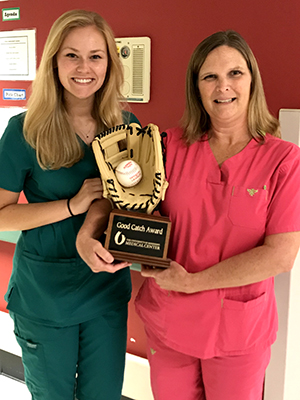- News
- Miscellaneous
- 2019
- June
- June 17, 2019
June 17, 2019
Peds nurses field Good Catch; stroke program makes GWTG honor roll

Peds nurses’ decisive actions – twice – earn Good Catch
Stacey Wilson and Blake Fulton didn’t just make one good catch to save a pediatric patient from harm: They followed the near-miss with another good catch and prompted a system redesign to keep the errors from happening again.

Wilson and Fulton, nurses on 5 Children’s, recognized an original blood transfusion order had an unsuitable volume for a child – one unit of blood rather than an order in the milliliters. When the order arrived on the floor, the nurses quickly determined the need to clarify the volume.
After the first near miss, the EPIC team began to work on a pediatric order setup to prevent a recurrence of the error. But before the new order could be implemented, there was a second, similar incident flagged by Wilson and Fulton.
A system redesign is being explored with EPIC to force a “hard stop” on any blood ordered for patients that weigh less than 20 kilograms.
Stroke program garners GWTG Elite Plus Honor Roll status

UMMC’s stroke program has been honored with the American Heart Association/American Stroke Association’s Get With the Guidelines-Gold Plus Target: Stroke Elite Plus Honor Roll Quality Achievement Award.
The award recognizes UMMC’s commitment and success during 2018 in implementing excellent care for stroke patients according to evidence-based guidelines. According to the AHA/ASA, stroke is one of the leading causes of death and serious, long-term disability in the United States.
It’s the 10th consecutive year that UMMC’s stroke program has been recognized by Get With the Guidelines, and the eighth year in a row that the program has received Gold Plus status.
“There are many areas and personnel throughout the hospital who provide outstanding stroke care daily as evidenced by not only this award, but also the achievement of awards over time,” said Neal Kiihnl, manager of UMMC’s stroke program.
To receive the award, the stroke program achieved 85 percent or higher adherence to all Get With the Guidelines-Stroke Quality Achievement indicators for two or more consecutive 12-month intervals and achieved 75 percent or higher compliance with five of eight Get With the Guidelines-Stroke Quality Measures, which are reporting initiatives to measure quality of care.
These measures include early use of medications, antithrombotics, anticoagulation therapy, DVT prophylaxis, cholesterol-reducing drugs and smoking cessation, all aimed at reducing death and disability and improving the lives of stroke patients.
According to the AHA/ASA, about one in four stroke patients have another stroke. Educating stroke patients, caregivers and family about risk factors and recognizing signs and symptoms of stroke is imperative to stroke prevention.


